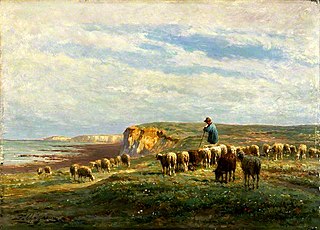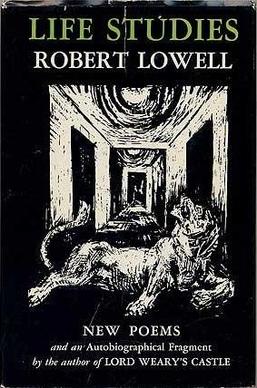Related Research Articles

Sylvia Plath was an American poet, novelist, and short story writer. She is credited with advancing the genre of confessional poetry and is best known for The Colossus and Other Poems (1960), Ariel (1965), and The Bell Jar, a semi-autobiographical novel published shortly before her suicide in 1963. The Collected Poems was published in 1981, which included previously unpublished works. For this collection Plath was awarded a Pulitzer Prize in Poetry in 1982, making her the fourth to receive this honor posthumously.

Edward James Hughes was an English poet, translator, and children's writer. Critics frequently rank him as one of the best poets of his generation and one of the twentieth century's greatest writers. He was appointed Poet Laureate in 1984 and held the office until his death. In 2008, The Times ranked Hughes fourth on its list of "The 50 greatest British writers since 1945".

A villanelle, also known as villanesque, is a nineteen-line poetic form consisting of five tercets followed by a quatrain. There are two refrains and two repeating rhymes, with the first and third lines of the first tercet repeated alternately at the end of each subsequent stanza until the last stanza, which includes both repeated lines. The villanelle is an example of a fixed verse form. The word derives from Latin, then Italian, and is related to the initial subject of the form being the pastoral.
Confessional poetry or "Confessionalism" is a style of poetry that emerged in the United States during the late 1950s and early 1960s. It is sometimes classified as a form of Postmodernism. It has been described as poetry of the personal or "I", focusing on extreme moments of individual experience, the psyche, and personal trauma, including previously and occasionally still taboo matters such as mental illness, sexuality, and suicide, often set in relation to broader social themes.
Confessional writing is a literary style and genre that developed in American writing schools following the Second World War. A prominent mode of confessional writing is confessional poetry, which emerged in the 1950s and 1960s. Confessional writing is often historically associated with Postmodernism due to the features which the modes share: including self-performativity and self-reflexivity; discussions of culturally taboo subjects; and the literary influences of personal conflict and historical trauma. Confessional writing also has historical origins in Catholic confessional practices. As such, confessional writing is congruent with psychoanalytic literary criticism. Confessional writing is also a form of life writing, especially through the autobiography form.

Ariel was the second book of Sylvia Plath's poetry to be published. It was first released in 1965, two years after her death by suicide. The poems of Ariel, with their free-flowing images and characteristically menacing psychic landscapes, marked a dramatic turn from Plath's earlier Colossus poems.

"Daddy" is a poem written by American confessional poet Sylvia Plath. The poem was composed on October 12, 1962, one month after her separation from Ted Hughes and four months before her death. It was published posthumously in Ariel during 1965 alongside many other of her final poems, such as "Tulips” and "Lady Lazarus". It has subsequently become a widely anthologized poem in American literature.
"Two Lovers and a Beachcomber by the Real Sea" is a poem written by Sylvia Plath that was first published in 1955, the year she graduated from Smith College summa cum laude. An abstract poem about an absent lover, it uses clear, vivid language to describe seaside scenery, with "a grim insistence" on reality rather than romance and imagination.
The following outline is provided as an overview of and introduction to poetry:

Life Studies is the fourth book of poems by Robert Lowell. Most critics consider it one of Lowell's most important books, and the Academy of American Poets named it one of their Groundbreaking Books. Helen Vendler called Life Studies Lowell's "most original book." It won the National Book Award for Poetry in 1960.
"Mad Girl's Love Song" is a poem written by Sylvia Plath in villanelle form that was published in the August 1953 issue of Mademoiselle, a New York based magazine geared toward young women. The poem explores a young woman's struggle between memory and madness. She wrote this poem as a third-year undergraduate at Smith College and described it as being one of her favorite poems that she had written. However, the poem was never republished or found in any of Plath's later collections during her lifetime. After her suicide, "Mad Girl's Love Song" appeared in the afterword of the reprint of The Bell Jar.
"Tulips" is a poem by American poet Sylvia Plath. The poem was written in 1961 and included in the collection Ariel published in 1965. The poem is written in nine stanzas in sixty-three lines.
Lady Lazarus is the first novel by O. Henry Award-winning writer Andrew Foster Altschul, published by Harcourt in 2008. Drawing its title from the poem of the same name by Sylvia Plath, Lady Lazarus also deals with themes similar to the poem, namely issues of exhibitionism and the public's hunger for tragedy and spectacle.

Rosa Jamali is an Iranian poet, translator, literary critic, and playwright.

Sylvia Plath (1932–1963) was an American author and poet. Plath is primarily known for her poetry, but earned her greatest reputation for her semi-autobiographical novel The Bell Jar, published pseudonymously weeks before her death.

"Ariel" is a poem written by the American poet Sylvia Plath. It was written on her thirtieth birthday, October 27, 1962, and published posthumously in the collection Ariel in 1965. Despite the poem's ambiguity, it is understood to describe an early morning horse-ride towards the rising sun. Scholars and literary critics have applied various methods of interpretation to "Ariel".
"One Art" is a poem by American poet Elizabeth Bishop, originally published in The New Yorker in 1976. Later that same year, Bishop included the poem in her book Geography III, which includes other works such as "In the Waiting Room" and "The Moose". It is considered to be one of the best villanelles in the English language, and is compared to the works of W.H. Auden, Dylan Thomas, Theodore Roethke, Sylvia Plath, and more.
"Sylvia’s Death" is a poem by American writer and poet Anne Sexton (1928–1974) written in 1963. "Sylvia's Death" was first seen within Sexton's short memoir “The Barfly Ought to Sing” for TriQuarterly magazine. The poem was also then included in her 1966 Pulitzer Prize winning collection of poems Live or Die. The poem is highly confessional in tone, focusing on the suicide of friend and fellow poet Sylvia Plath in 1963, as well as Sexton's own yearning for death. Due to the fact that Sexton wrote the poem only days after Plath's passing within February 1963, "Sylvia’s Death" is often seen as an elegy for Plath. The poem is also thought to have underlying themes of female suppression, suffering, and death due to the confines of domesticity subsequent of the patriarchy.

"The Applicant" is a poem written by American confessional poet Sylvia Plath on October 11, 1962. It was first published on January 17, 1963 in The London Magazine and was later republished in 1965 in Ariel alongside poems such as "Daddy" and "Lady Lazarus" two years after her death.
Persona poetry is poetry that is written from the perspective of a 'persona' that a poet creates, who is the speaker of the poem. Dramatic monologues are a type of persona poem, because "as they must create a character, necessarily create a persona".
References
- Footnotes
- 1 2 Uroff, M. D. (January 1977). "Sylvia Plath and Confessional Poetry: A Reconsideration". The Iowa Review. 8 (1): 104–115. doi: 10.17077/0021-065x.2172 . ISSN 0021-065X.
- 1 2 Ghasemi, Parvin (2008). "Violence, Rage, and Self-Hurt in Sylvia Plath's Poetry". CLA Journal. 51 (3): 292. ISSN 0007-8549. JSTOR 44325429.
- ↑ Aird, Eileen (December 1979). "?Poem for a birthday? to ?Three women?: development in the poetry of Sylvia Plath". Critical Quarterly. 21 (4): 70. doi:10.1111/j.1467-8705.1979.tb01735.x. ISSN 0011-1562.
- 1 2 Fermaglich (2007), p. 14
- 1 2 Clark, Heather L. (28 September 2021). Red comet: The Short Life and Blazing Art of Sylvia Plath. ISBN 978-0-307-95126-7. OCLC 1231956674.
- ↑ "Lady Lazarus by Sylvia Plath". Poetry Foundation. 2021-10-23. Retrieved 2021-10-24.
- ↑ Ghasemi, Parvin (2008). "Violence, Rage, and Self-Hurt in Sylvia Plath's Poetry". CLA Journal. 51 (3): 284–303. ISSN 0007-8549. JSTOR 44325429.
- ↑ Schetrumpf, Tegan Jane (2015). "Diminished but Never Dismissed: The Confessional Poetry of Sylvia Plath and Bruce Beaver". Antipodes. 29 (1): 117–127. doi:10.13110/antipodes.29.1.0117. ISSN 0893-5580. JSTOR 10.13110/antipodes.29.1.0117.
- ↑ "BBC - Arts - Poetry: Out Loud".
- ↑ Clark, Heather L. (28 September 2021). Red comet : the short life and blazing art of Sylvia Plath. p. 806. ISBN 978-0-307-95126-7. OCLC 1231956674.
- ↑ Suiter Gentry (2006), p. 78
- ↑ Britzolakis (1999), p. 155
- Sources
- Britzolakis, Christina (1999). Sylvia Plath and the Theatre of Mourning. Oxford University Press. ISBN 0-19-818373-9.
- Fermaglich, Kirsten (2007). American Dreams and Nazi Nightmares: Early Holocaust Consciousness and Liberal America, 1957–1965. University Press of New England. ISBN 978-1-58465-549-7.
- Gill, Jo (2006). The Cambridge Companion to Sylvia Plath. Cambridge University Press. ISBN 0-521-84496-7.
- Runkel, Anne (2009). Sylvia Plath's "Lady Lazarus" – Cultural and Social Context. GRIN Verlag. ISBN 978-3-640-32902-1.
- Suiter Gentry, Deborah (2006). The Art of Dying: Suicide in the Works of Kate Chopin and Sylvia Plath. Peter Lang. ISBN 0-8204-2496-X.